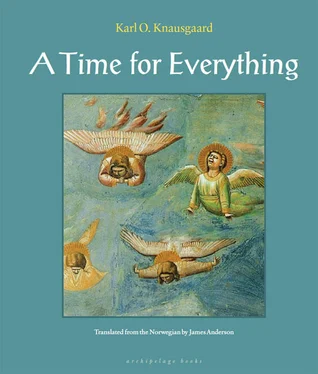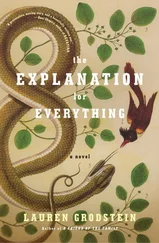Of course it wasn’t just from this mansion that the angels were banished. The same thing happened everywhere that human beings lived. Doors were locked, windows shut. They weren’t even welcome in the churches anymore, people were fed up with their mess there as well, and by the start of the eighteenth century almost all the angels were surviving on what they could scavenge of garbage and remains in back streets and alleys. Soon they were even more unwelcome than they’d feared they would be in their old guise. Things were bad, very bad. They weren’t happy, especially because they must surely have been able to remember how things had once been, when they were divine. But it was soon to get even worse. No matter how strongly earthly things had gotten hold of them before, there had always been a distance between them and the earth they walked on. Desire, savagery, fury, hunger were all facets that had always been there within them. Even though terrestrial things tore at and embroiled them, they never altered them, they only reinforced characteristics they already had. But when they turned themselves into childlike creatures, they also moved toward the boundary of the earthly, too far toward it as it was to prove, for in that form earthly things got a hold over them, they got caught up, or were hurled into earthly things, the distance was removed, and the laws that apply to the terrestrial suddenly also applied to them. It was what Scarlatti had seen and so succinctly described: they had two souls. One that was driving them ever deeper into earthly life, and one that resisted, perhaps remembering who they were and where they’d come from. Naturally it’s impossible to say how much they understood of what was happening to them. But they must have noticed it. The alterations to their physiognomy were extensive, and happened quickly. They got smaller, their legs became thinner, and the feathers, which previously had only covered their wings, began to sprout on other parts of their bodies.
That was a time of despair for them. For although their minds had become more and more depraved, they still had remembered glimpses of what they’d once been. Then shrilly they wailed out their woes. Roosting under a roof they would sit plucking out feathers until their gnawing hunger grew so great that they couldn’t think about anything else and had to take to the wing once more and fly off looking for rubbish to satisfy it. Over the course of the next century their noses and mouths grew together into hard, bony beaks; those eyes, formerly so sensitive, lost all their powers of expression, until at last they possessed only one, a stiff and fixed stare straight ahead, no matter what was happening or how their bodies were moving; their toes turned into claws, while their arms and hands shrunk and finally hung there just beneath their wings, tiny and unusable, concealed by a thick down of feathers, but still intact, and ultimately the only remaining physiological link with their once proud past. After a few generations the human mind separated the memory of the angels and these creatures. By the end of the eighteenth century there was no connection between the angels as they were described in the Bible and in medieval manuscripts and angels as they appeared at the time, so fatally birdlike as they were in both character and appearance. They’d lost the competition for the town’s garbage to other birds and small animals, so they were driven away from there as well, out to the coast, where they gradually made a niche for themselves, and not only survived as a species but also became a biological success.
THE INHABITANTS of the Norwegian coast must have been nonplussed by the flocks of seagulls that began to appear toward the end of the eighteenth century, and they must have been amazed, perhaps even intimidated, by the strange mixture of aggressive persistence and wariness, of sagacity and simplicity, that these creatures displayed. Unlike other birds, they associated with people and hung like a veil in the wind after fishing boats, giving their melancholy wail — kyyyyow-kyyyow-kyow-gah-gah-gah — while always being careful to keep their distance, and refusing to pick up food the fishermen threw to them before they saw it floating on the surface. With astonishing deftness they would then dive and take the prize in their beaks, only to lose it again in the violent scuffle that always followed, the melee of thrashing wings and greedy cries, which each day filled the air above inlets and bays the whole length of the coast, and gradually extended inland during the twentieth century, when the spectacle of enormous flocks of gulls gathering on the landfill sites on the edges of cities became more and more common, as if they’d used their time on the coast to train and now were at last prepared to take up the cudgels against the rats, pigeons, dogs, and cats that had once driven them out. They even settled deep in the countryside, where they followed the tractor across the fields, as if it were a fishing boat on the water.
The origin of seagulls is uncertain. The first Norwegian to describe them was Peder Claussøn Friis, priest of Audnedal and Stavanger, in 1632 in his work The True Description of Norway and Its Surrounding Isles , which contains the following mysterious statement about them: These are the first summer birds to arrive in spring: seagulls, shoregulls, black gulls . That’s all. Although this doesn’t tell us when or how they developed, the description is nevertheless invaluable, as it allows us to state with absolute certainty that there were gulls in Norway at the beginning of the seventeenth century. That gulls existed before that time is quite possible, but no one can corroborate it. As we know, evolutionists maintain that all life originally came from the sea, in the shape of single-celled organisms that over time came together, gradually becoming more complex and specialized, in accordance with the demands made by their environments, and controlled by the principle that the best adapted always survived, so some remained unchanged, some died out, and some developed in new directions. This, according to evolutionists, applies to all living things, and, of course, to seagulls. Some of them quite seriously believe that birds have developed from dinosaurs, while more moderate theories say that modern birds are descended from certain primeval ones, coarser and simpler than those of today. They claim that fossils prove them right, but fossils show only that other creatures have existed on earth. The development hasn’t left any trace, and when they say they can read the past by studying signs in nature, they do no more than the Assyrians and Babylonians did when they looked for portents of the future in viscera or the night sky. It may seem impressive, but science it isn’t, except in name.
The only thing we really know about seagulls in Norway is that there were three kinds in 1632: seagulls, shoregulls, and black gulls. Furthermore we know that something happened to these gull species about a hundred years later. They underwent a kind of change. Their wings got a trifle longer, their feathers a trifle whiter, their knees a trifle gristlier. Their behavior became more aggressive, while a streak of shrewdness simultaneously began to manifest itself in their character. This was the change the inhabitants of the Norwegian coastal regions witnessed at the start of the eighteenth century. A new kind of gull had arrived. It looked like an ordinary gull, it moved like an ordinary gull, it sounded like an ordinary gull, and it behaved like an ordinary gull. But with some small and, for the custom-rooted Norwegians, almost spectacular differences. It followed them! For days it might hover in the wind above their boats. And in the instant they sliced the head off a fish, it came diving down and grabbed guts and intestines with its strong yellow beak. No other bird had done this before. And while other birds kept a constant distance from man, whether it was the tame bird’s extreme proximity or the bird of prey’s haughty aloofness, the gull’s distance altered continually, and that was the strange thing, how the distance between this new bird and man was regulated by things beyond the purely spatial.
Читать дальше












